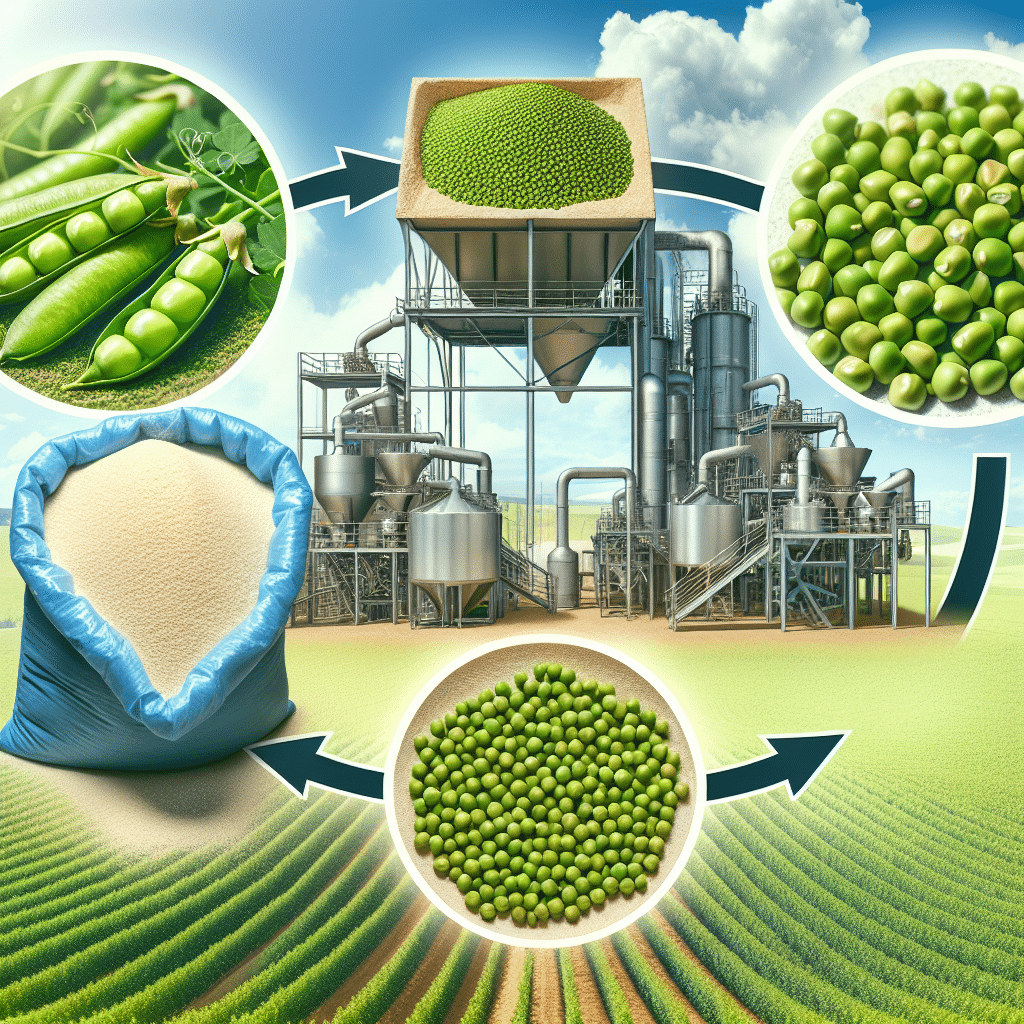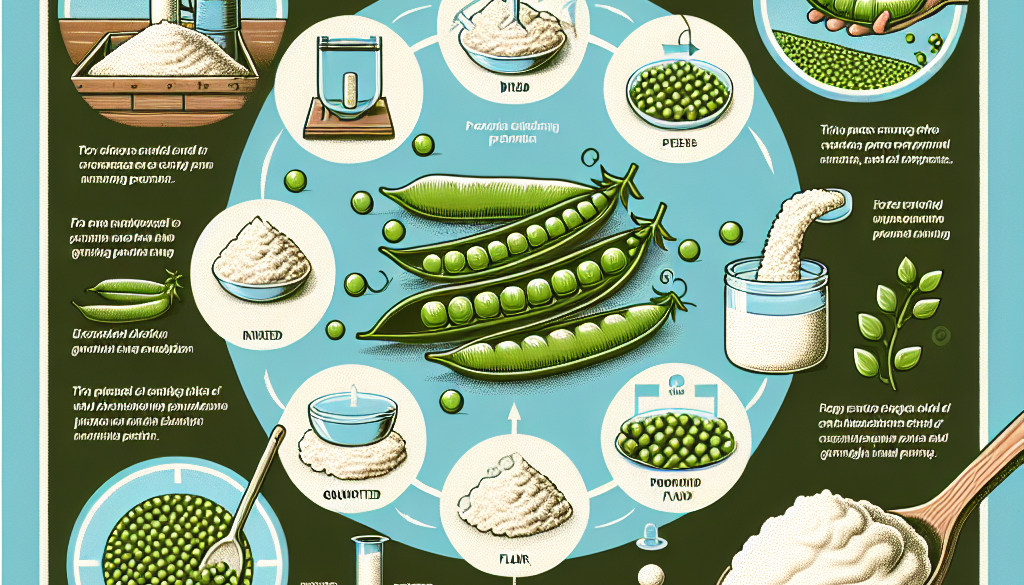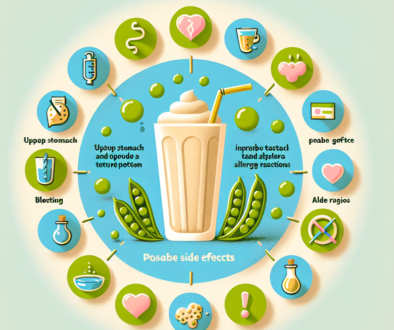What Is Textured Pea Protein Made From?
-
Table of Contents
- Textured Pea Protein: A Comprehensive Guide to Its Origins and Benefits
- Understanding Textured Pea Protein
- The Source: Yellow Peas
- Extraction and Texturization Process
- Nutritional Profile of Textured Pea Protein
- Applications in the Food Industry
- Meat Alternatives
- Dairy-Free Products
- Protein-Rich Snacks
- Environmental and Health Benefits
- Case Studies and Statistics
- Conclusion: The Future of Protein Is Plant-Based
- Discover ETprotein’s High-Quality Protein Products
Textured Pea Protein: A Comprehensive Guide to Its Origins and Benefits

Textured pea protein has emerged as a popular ingredient in the world of plant-based nutrition, offering a sustainable and allergen-friendly alternative to traditional animal proteins. This versatile food product is not only rich in essential nutrients but also provides a meat-like texture that appeals to both vegetarians and meat-eaters alike. In this article, we will delve into the origins of textured pea protein, its manufacturing process, nutritional profile, and its role in the food industry.
Understanding Textured Pea Protein
Textured pea protein is derived from yellow peas, a legume known for its high protein content. The process of making textured pea protein involves several steps, starting from the humble pea to the final textured product that is used in various culinary applications.
The Source: Yellow Peas
Yellow peas, also known as Pisum sativum, are the primary raw material for textured pea protein. These peas are a type of pulse, which are part of the legume family and are known for their environmental benefits, such as nitrogen-fixing properties that improve soil fertility.
Extraction and Texturization Process
The production of textured pea protein begins with the milling of yellow peas to remove the outer shell and separate the protein from the starch and fiber. The protein is then concentrated and isolated to achieve a high protein content. The texturization process involves using an extruder, which subjects the pea protein to high temperatures and pressures, resulting in a fibrous structure that mimics the texture of meat.
Nutritional Profile of Textured Pea Protein
Textured pea protein is not only valued for its textural properties but also for its impressive nutritional profile. It is a complete protein, containing all nine essential amino acids required by the human body. Additionally, it is rich in iron and has a low glycemic index, making it a suitable option for those managing blood sugar levels.
- High Protein Content: Textured pea protein typically contains around 50-80% protein, depending on the level of concentration.
- Essential Amino Acids: It includes branched-chain amino acids (BCAAs) like leucine, isoleucine, and valine, which are crucial for muscle synthesis and recovery.
- Iron-Rich: This plant-based protein is a good source of iron, an essential mineral for transporting oxygen in the blood.
- Dietary Fiber: Although the texturization process reduces the fiber content, textured pea protein still retains some dietary fiber.
Applications in the Food Industry
Textured pea protein has found its way into a variety of food products due to its functional properties. It is commonly used in meat alternatives, such as veggie burgers, sausages, and ground meat substitutes. Its ability to absorb flavors and its meat-like texture make it an ideal ingredient for plant-based product formulations.
Meat Alternatives
One of the most significant applications of textured pea protein is in the creation of meat alternatives. Brands have successfully used it to replicate the taste and texture of beef, chicken, and pork, offering consumers a plant-based option without compromising on sensory experience.
Dairy-Free Products
Textured pea protein is also utilized in dairy-free products like cheese and yogurt alternatives. Its high protein content helps to enhance the nutritional value of these products, which are often sought after by vegans and those with lactose intolerance.
Protein-Rich Snacks
Snack manufacturers are incorporating textured pea protein into bars, chips, and other snack items to boost their protein content and appeal to health-conscious consumers.
Environmental and Health Benefits
The production of textured pea protein has a lower environmental footprint compared to animal-based proteins. Peas require less water and land to grow and do not produce as much greenhouse gas emissions. From a health perspective, textured pea protein is free from common allergens like soy, gluten, and dairy, making it suitable for individuals with dietary restrictions.
Case Studies and Statistics
Several studies have highlighted the benefits of incorporating plant-based proteins like textured pea protein into the diet. For instance, research has shown that plant-based diets can lead to improved heart health, weight management, and reduced risk of chronic diseases. The market for plant-based proteins is also growing rapidly, with the global pea protein market expected to reach significant growth by the end of the decade.
Conclusion: The Future of Protein Is Plant-Based
Textured pea protein is a sustainable, nutritious, and versatile ingredient that is revolutionizing the food industry. Its ability to provide a meat-like experience without the environmental and health drawbacks of animal proteins makes it an attractive option for consumers and manufacturers alike. As the demand for plant-based products continues to rise, textured pea protein is poised to play a pivotal role in shaping the future of food.
Discover ETprotein’s High-Quality Protein Products
If you’re looking for premium plant-based protein options, ETprotein offers a range of products that cater to various industries. Their textured pea protein is characterized by its neutral taste, non-GMO, and allergen-free attributes, making it an excellent choice for your protein needs.
About ETprotein:
ETprotein, a reputable protein and L-(+)-Ergothioneine (EGT) Chinese factory manufacturer and supplier, is renowned for producing, stocking, exporting, and delivering the highest quality organic bulk vegan proteins and L-(+)-Ergothioneine. They include Organic rice protein, clear rice protein, pea protein, clear pea protein, watermelon seed protein, pumpkin seed protein, sunflower seed protein, mung bean protein, peanut protein, and L-(+)-Ergothioneine EGT Pharmaceutical grade, L-(+)-Ergothioneine EGT food grade, L-(+)-Ergothioneine EGT cosmetic grade, L-(+)-Ergothioneine EGT reference grade and L-(+)-Ergothioneine EGT standard. Their offerings, characterized by a neutral taste, non-GMO, allergen-free attributes, with L-(+)-Ergothioneine purity over 98%, 99%, cater to a diverse range of industries. They serve nutraceutical, pharmaceutical, cosmeceutical, veterinary, as well as food and beverage finished product distributors, traders, and manufacturers across Europe, USA, Canada, Australia, Thailand, Japan, Korea, Brazil, and Chile, among others.
ETprotein specialization includes exporting and delivering tailor-made protein powder and finished nutritional supplements. Their extensive product range covers sectors like Food and Beverage, Sports Nutrition, Weight Management, Dietary Supplements, Health and Wellness Products, and Infant Formula, ensuring comprehensive solutions to meet all your protein needs.
As a trusted company by leading global food and beverage brands and Fortune 500 companies, ETprotein reinforces China’s reputation in the global arena. For more information or to sample their products, please contact them and email sales(at)ETprotein.com today.














